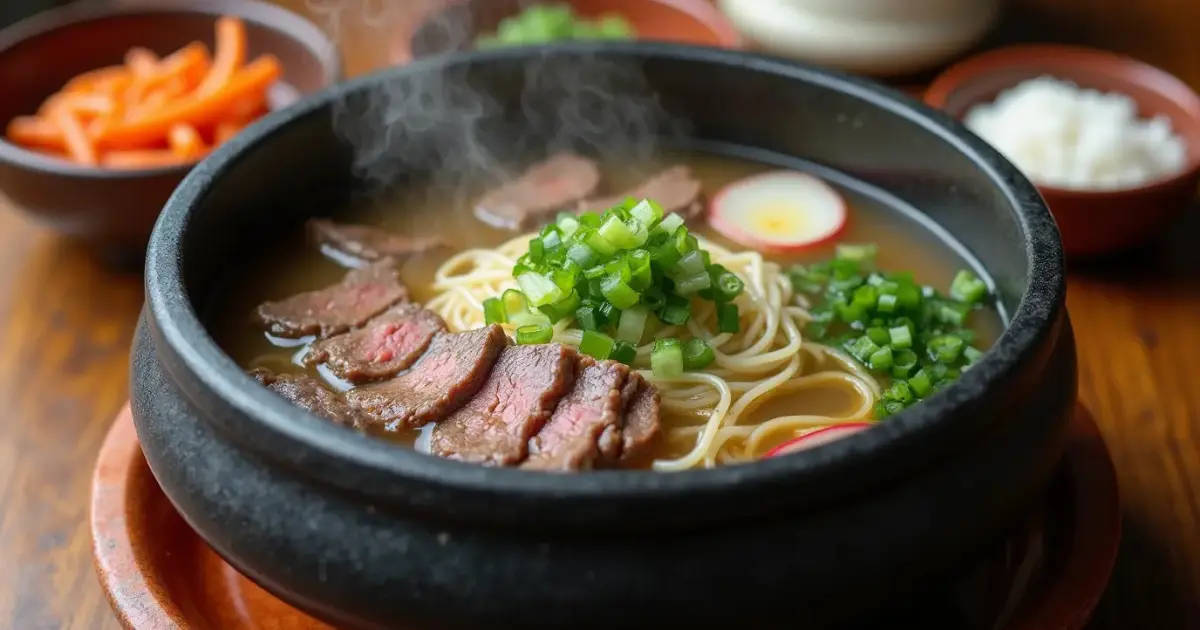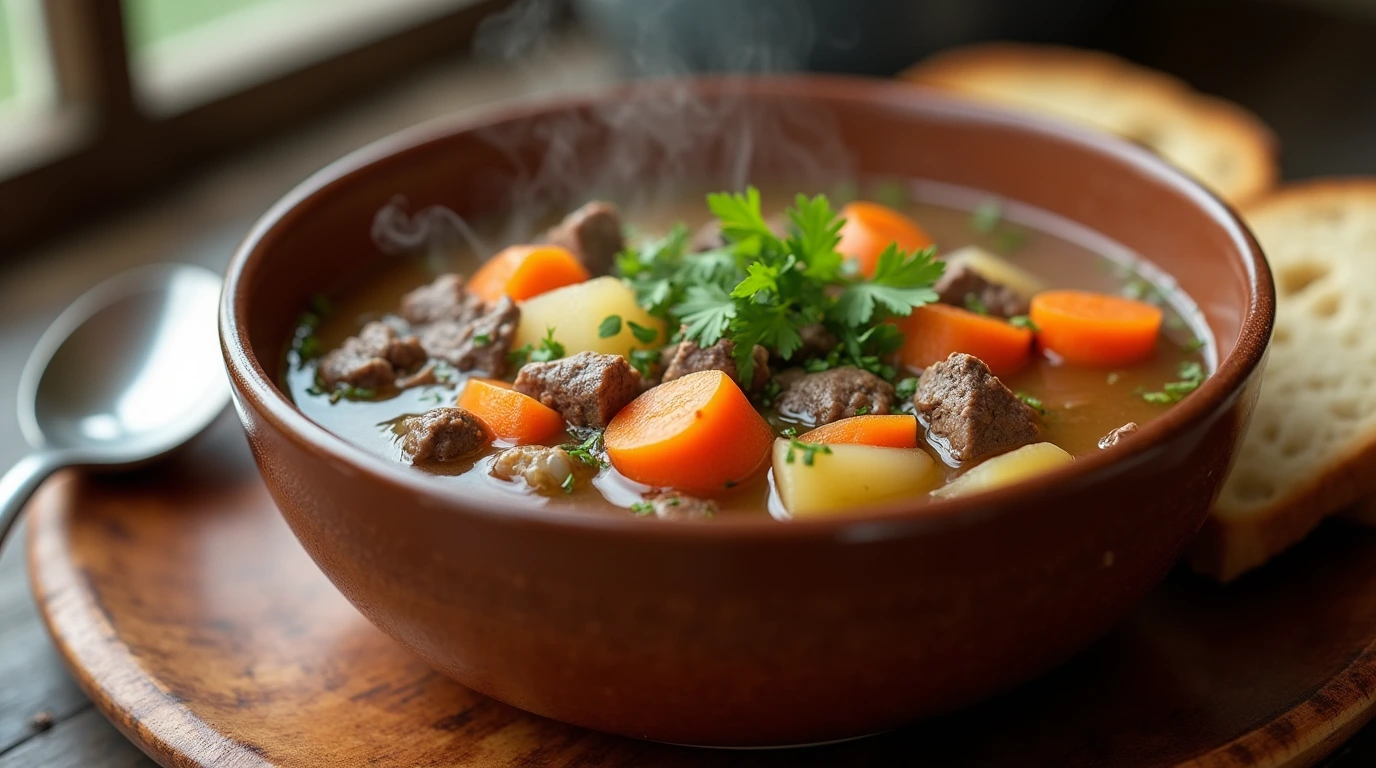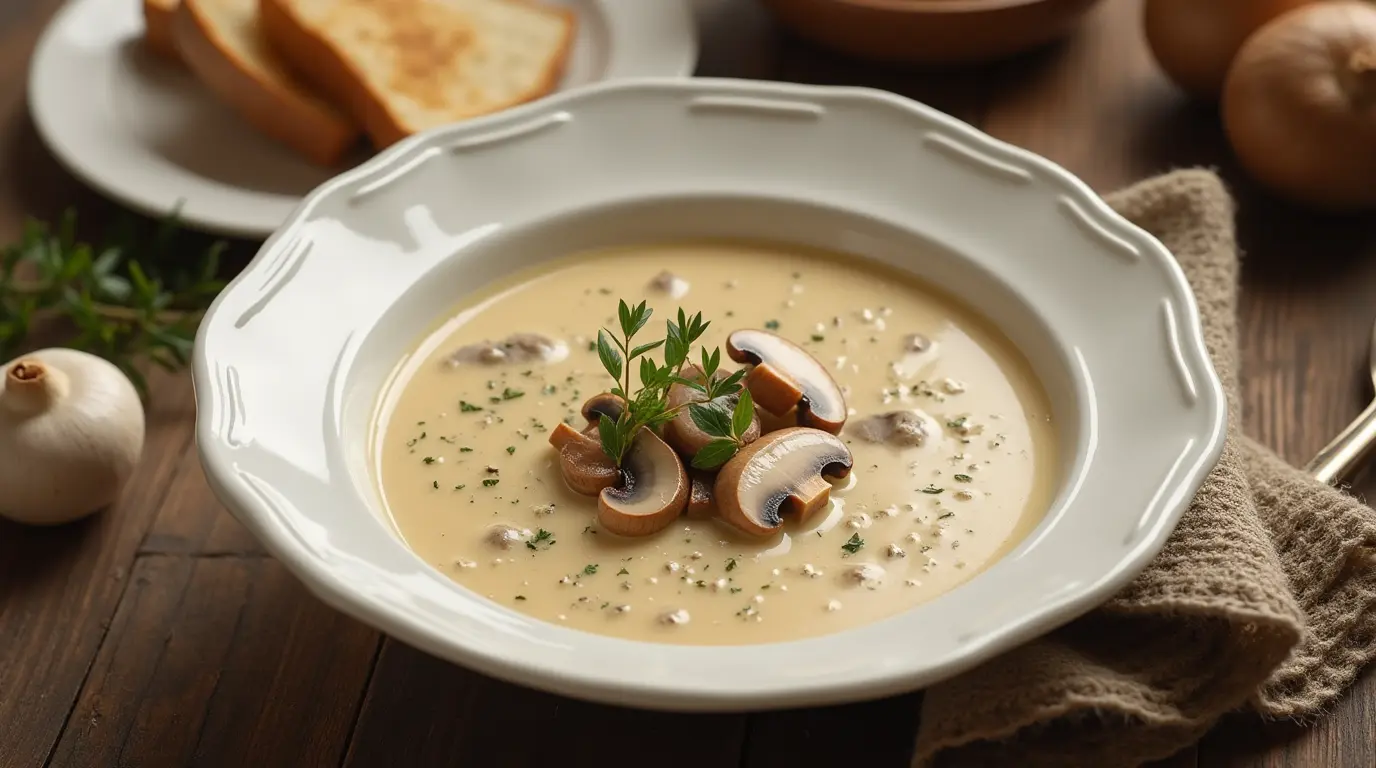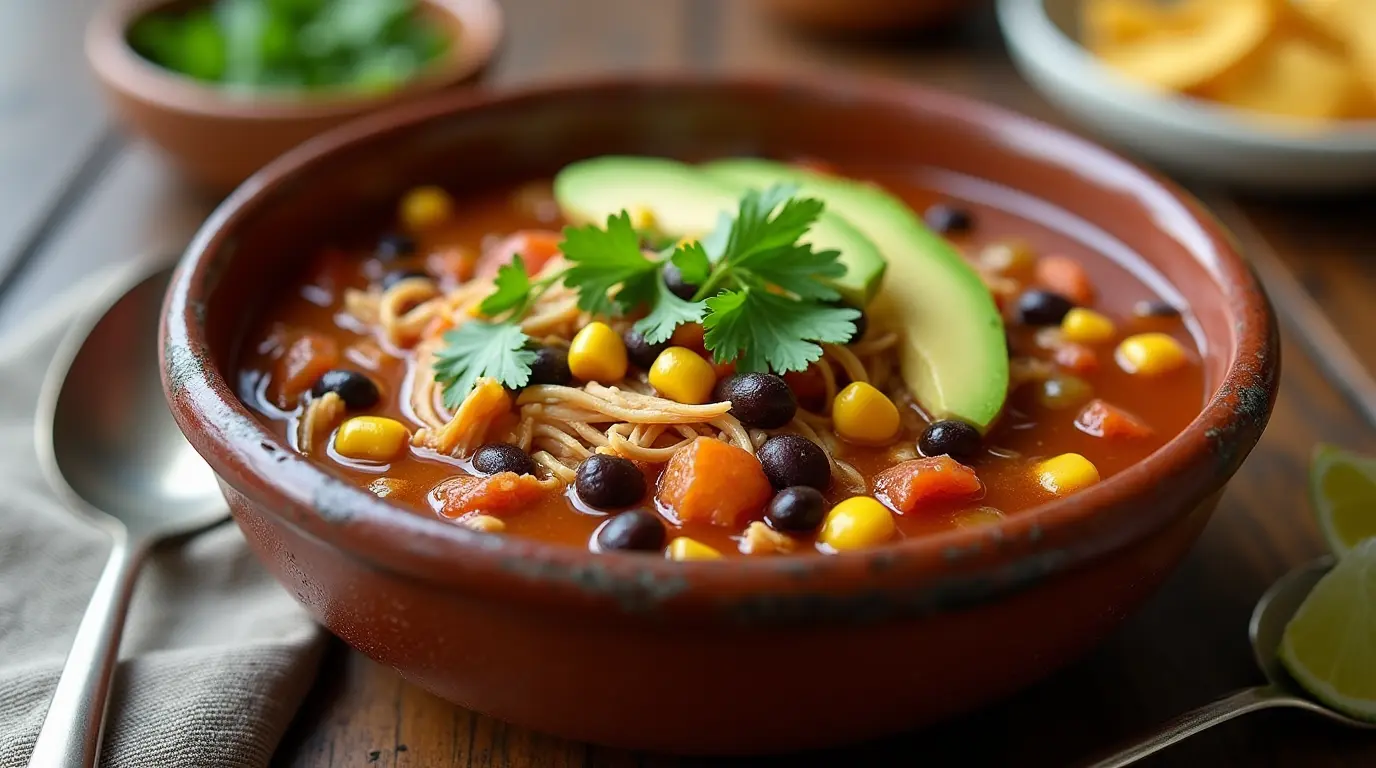Imagine you’re in your kitchen, surrounded by new ingredients. The recipe for Yi’s traditional Korean beef soup seems like a secret from another time. It’s a dish filled with family stories and warmth.
For beginners, cooking this soup is more than just following a recipe. It’s about joining a tradition that connects us all. Every spoonful tells a story of love and shared moments.
Table of Contents
Key Takeaways
- Focus on quality ingredients to capture authentic flavors.
- Slow simmering is key to unlocking the broth’s depth.
- Follow step-by-step guidance to avoid common mistakes.
- Explore cultural context to deepen your cooking experience.
- Embrace small adjustments to make the dish your own.
Introduction to Yi’s Traditional Beef Soup Journey
Step into the centuries-old tradition of Yi’s Traditional Korean Beef Soup. This dish is more than a meal; it’s a legacy. For generations, Korean families have loved this soup. Yi’s menu keeps this heritage alive.
Every bowl tells a story of cultural pride and careful preparation. It blends history with modern enjoyment.
Background of the Recipe
Yi’s recipe comes from Korea’s culinary past. It has been passed down for over a century. It carries ancestral wisdom.
The menu today honors its history while appealing to today’s tastes.
“This soup is our family’s promise to tradition,” shares Master Chef Lee, custodian of Yi’s recipes. “Every ingredient carries the essence of our ancestors’ knowledge.”
What Makes It Special
Three elements make it unique:
- Generational Mastery: Cooking techniques refined over decades ensure unmatched depth.
- Pure Ingredients: Only premium cuts and natural seasonings are used.
- Cultural Authenticity: The menu stays true to Korea’s culinary soul.
| Key Feature | Impact |
|---|---|
| Slow Simmering | Unlocks rich flavors in the broth |
| Heritage-Tested Methods | Guarantees authenticity |
| Seasonal Ingredients | Enhances freshness and balance |
Exploring Yi’s menu is more than just eating. It’s a journey through time, culture, and craft.
Key Ingredients for Authentic Flavor
Making 전통설렁탕 starts with top-notch ingredients. The right stuff makes the broth rich and the dish true to its roots. Let’s dive into what makes this soup stand out.
Beef Cuts
Start with beef like brisket or short ribs. These cuts get tender in slow cooking, adding to the broth’s richness. Choose grass-fed or organic for a cleaner taste.
Fresh Vegetables and Herbs
Onions, leeks, and garlic are the broth’s sweet base. Add scallions and Korean chives for a fresh touch. Buying from Federal Way markets ensures the best quality. Look for crisp, fresh produce to keep the broth balanced.
Traditional Seasonings
- Doenjang (soybean paste): Adds depth without taking over.
- Gochujang (red chili paste): Use it to enhance, not overwhelm, the taste.
- Korean sesame oil: Add a small amount before serving for a nice aroma.
Using these seasonings with Federal Way’s local ingredients creates a perfect blend of traditional and regional flavors.
Essential Equipment and Preparation Steps
Success with yi’s traditional beef soup begins with the right tools and preparation. These steps make the process easier and ensure your broth simmers perfectly.
Choosing the Right Pot
A sturdy pot is key for even heat. Look for these options:
- Clay pot: Retains heat and enhances broth depth
- Heavy-bottomed stainless steel: Prevents burning
- Earthenware: Adds earthy flavors during slow cooking
| Pot Material | Why It’s Best | Key Features |
|---|---|---|
| Clay | Enhances broth richness | Porcelain-lined for durability |
| Stainless Steel | Even heat conduction | Heavy base resists warping |
| Earthenware | Traditionally preferred | Non-reactive surface |
Prepping Ingredients Effectively
Follow these steps to streamline your cooking:
- Rinse beef under cold water to remove impurities
- Chop vegetables into uniform pieces for even cooking
- Soak dried mushrooms 20 minutes before use
Note: Pat beef dry before searing to achieve better browning.
Understanding the Authentic Techniques
Learning Yi’s traditional Korean beef soup means honoring old ways but also fitting them into today’s kitchens. Begin by cooking bones and meat slowly for hours. This method makes the flavors richer without burning.
Don’t stir the ingredients too much. This helps keep the broth clear and smooth, just like in yi’s traditional korean beef soup photos.
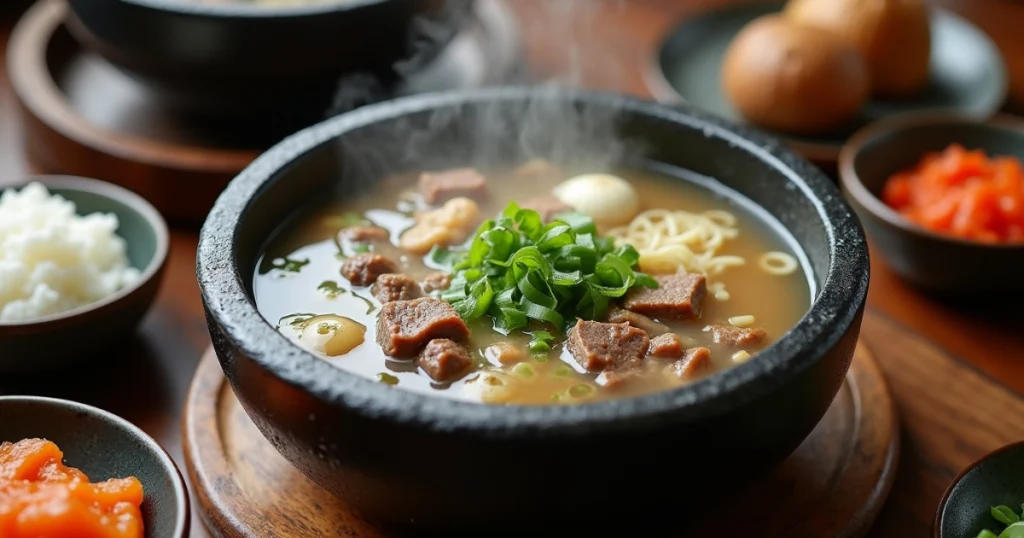
Traditional cooking is all about balance. Add salt only at the end to keep veggies moist. Use a big pot to cook everything evenly. These steps help keep the soup’s unique taste.
- Simmer bones 2–3 hours before adding tender cuts for layered flavor
- Float green onions and garlic slices on top for a final burst of freshness
- Present in deep bowls to highlight broth clarity—seen in professional yi’s traditional korean beef soup photos
Follow these steps to truly capture the dish’s spirit. Each method respects ancient traditions, making every bowl a blend of heritage and personal flair. With the right techniques, your soup will taste and look as authentic as the best Seoul restaurants.
Step-by-Step Guide to Cooking the Soup
Learn to make 전통설렁탕 with these easy steps. Follow each step closely to get a broth as rich as Lynnwood’s famous ones.
Simmering the Rich Broth
- Heat a stainless steel pot over medium heat. Add beef bones and sear until golden.
- Boil 8 cups water, then reduce to a gentle simmer. Skim foam regularly.
- Cover and cook for 4–5 hours, adjusting heat to maintain a slow boil.
Structured Cooking Process
- After simmering, add sliced beef and vegetables. Cook for 20 minutes.
- Season with salt and garlic just before serving to preserve freshness.
- Strain broth if desired, but leave solids for added texture.
Plating and Serving Suggestions
| Style | Accompaniments | Tip |
|---|---|---|
| Traditional | Raw egg, bean sprouts | Serve in wide bowls for garnishing. |
| Lynnwood Variation | Spicy sauce, rice cakes | Add sesame leaves for local flair. |
Pair with steamed rice for balance. Visit Lynnwood’s authentic restaurants to compare your results with expert versions.
Mastering yi’s traditional korean beef soup: Insider Techniques
Take your broth to new heights with these refined methods used by experts. Every detail from simmer time to seasoning plays a role in crafting the authentic taste of Yi’s traditional Korean beef soup.
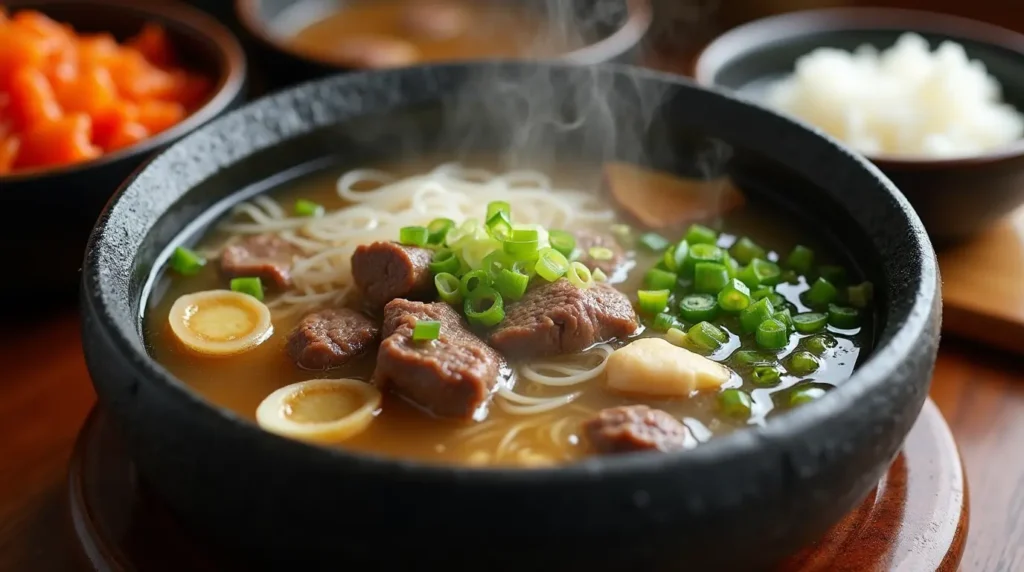
Achieving the Perfect Simmer
Simmering isn’t just heat—timing is key. Use a heavy pot to maintain consistent warmth. Here’s how:
- Simmer at a gentle bubble (180°F–190°F) to prevent bitterness
- Skim foam regularly to keep broth clear and clean
Balancing Flavors Precisely
Adjust seasonings gradually to avoid overpowering the beef’s natural taste. Try:
- Add soy sauce last to preserve freshness
- Use a dash of rice wine vinegar to brighten flavors
Final Touches for Authenticity
These details make the difference between good and extraordinary. Use this table to perfect your dish:
| Technique | Action | Result |
|---|---|---|
| Garnish | Top with thinly sliced garlic and green onions | Enhances aroma and visual appeal |
| Temperature | Bring to a boil, then lower to a slow simmer | Locks in beef tenderness |
Remember, the best Yi’s traditional Korean beef soup balances tradition with precision—every step counts.
Exploring the yi’s traditional korean beef soup Menu Options
Discover new flavors with Yi’s traditional Korean beef soup menu options. You can choose from bold tastes or lighter options. These choices keep the dish’s roots alive while appealing to today’s palates. Learn how to make it your own without losing its essence.
- Vegetable-Forward Bowls: Add glass noodles or spinach for texture.
- Spicy Infusions: Stir in gochugaru for heat.
- Protein Swaps: Try pork or tofu for dietary flexibility.
Variations of the Traditional Recipe
| Option | Description |
|---|---|
| Citrus Twist | Finish with a squeeze of yuzu or lemon. |
| Herb-Focused | Top with fresh cilantro or scallions. |
| Broth Intensity | Simmer bones longer for deeper flavor. |
Substitutions and Upgrades
Adjust ingredients to suit preferences:
- Gluten-Free: Use tamari instead of soy sauce.
- Low-Sodium: Reduce salt in seasoning blends.
- Richer Texture: Add silken tofu mid-simmer.
Try these options to make a yi’s traditional korean beef soup menu that’s all your own. Whether you’re eating out or cooking at home, these changes make every bowl special.
Secrets Behind Yi’s Traditional Beef Soup Recipes
Discover the secrets of Yi’s broth. For generations, 전통설렁탕 has been mastered in federal way homes. These methods have been passed down, making each bowl a piece of history.
“The soup’s soul is in the bones and time,” shares Chef Young-ja Yi, fifth-generation recipe keeper.
Family Heritage and Time-Honored Methods
Every step in making the soup goes back to our ancestors. Bones simmer for 10-12 hours to make the broth rich. Skimming impurities three times a day is key to the soup’s clear, golden color.
Insider Tips Passed Through Generations
Here are some pro tips:
- Marinate beef knuckle joints in cold water overnight
- Never boil—gentle bubbles maintain delicate flavors
- Season only with mountain-grown onions and dried chili flakes
These tips, shared in Federal Way kitchens, help anyone become a master chef. Visit federal way markets for authentic ingredients like Jeju Island beef for the best taste.
Locating the Best Spots for 전통설렁탕 in Your Area
Looking for the best yi’s traditional beef soup? Check out local eateries known for their authentic versions. Whether you’re in Federal Way or Lynnwood, these tips will help you find the right spot for authentic flavors.
전통설렁탕 Federal Way Favorites
In Federal Way, hanil jjimdak house and samyang market are top choices. They use traditional methods to make their slow-simmered broths. Their menus feature bone marrow-rich cuts for extra flavor.
Discovering 전통설렁탕 Lynnwood Classics
In Lynnwood, gwangalli bbq and seoul garden are favorites among locals. They use heirloom seasonings and simmer meats for hours. This matches the yi’s traditional beef soup techniques.
| Restaurant | Location | Signature Touch |
|---|---|---|
| Hanil Jjimdak House | Federal Way | Beef knuckle slow-cooked 12 hours |
| Seoul Garden | Lynnwood | Handpicked Korean herbs in broth |
Community-Recommended Eateries
“The best spots are those where servers explain broth-making secrets,” says local food expert Kim Young-jin. “Check for places offering handmade dumplings or jujube garnishes.”
Ask servers about simmer times and ingredient sources. Top-rated spots often post kitchen photos showing bones and spices.
Capturing the Perfect yi’s traditional korean beef soup Photos
Sharing your bowl of yi’s traditional korean beef soup photos is more than just a quick snap. Follow these steps to make every dish Instagram-worthy.
Presentation and Plating Ideas
- Use a white porcelain bowl to let the soup’s golden broth shine.
- Arrange green onions in a diagonal pattern over the surface.
- Add a sprinkle of toasted sesame seeds for texture contrast.
Lighting and Composition Techniques
Optimize your setup with these strategies:
| Tip | How to Apply | Why It Works |
|---|---|---|
| Window Light | Position bowl near a sunlit window at noon. | Soft, even light highlights broth clarity without glare. |
| Steaming Effect | Heat the soup briefly before shooting. | Rising steam adds dynamic energy to photos. |
| Angle Matters | Shoot from a 45-degree angle. | Showcase both the bowl and garnishes effectively. |
Tips for Sharing on Social Media
Turn your photos into viral content with these steps:
- Tag Yi’s Korean Kitchen in posts to connect with enthusiasts.
- Pair images with short captions like “Savoring the warmth of authentic Seoul-style broth.”
- Use #YIsBeefSoup and #KoreanComfortFood to reach food lovers.
Conclusion
Exploring Yi’s traditional Korean beef soup shows the importance of balancing ingredients and patience. Every step, from picking the right beef to mastering the simmer, shapes the broth’s depth. This dish is more than a meal—it’s a connection to centuries of culinary tradition.
For those near Lynnwood, finding authentic 전통설렁탕 spots in the area is a chance to taste this legacy firsthand. Local eateries in Lynnwood keep these methods alive, ensuring each bowl has genuine Korean flavors. Whether cooking at home or enjoying it locally, the focus is on honoring the recipe’s roots.
Let this journey inspire your kitchen experiments. Adjust seasonings, explore Lynnwood’s culinary gems, or share the broth’s warmth with others. Traditional dishes like 전통설렁탕 lynnwood remind us that food bridges cultures and generations. Your next bowl is more than a meal—it’s a story waiting to be tasted.
FAQ
What are the key ingredients in Yi’s Traditional Korean Beef Soup?
Yi’s Traditional Korean Beef Soup needs top-notch beef like brisket or shank. It also calls for fresh veggies like radish and scallions. Traditional seasonings like garlic, salt, and sesame oil are key. These ingredients blend to create the dish’s authentic taste.
How can I achieve the perfect simmer for my soup?
Start by boiling your broth hard, then turn the heat down to low. Let it simmer gently. This way, you get the most flavor from the beef and a clear broth.
What makes Yi’s Traditional Korean Beef Soup unique?
Yi’s soup stands out because of its quality ingredients and cooking methods. The mix of fresh veggies and rich beef offers a memorable taste. It’s a dish with deep cultural roots.
Can I find Yi’s Traditional Korean Beef Soup in Federal Way or Lynnwood?
Yes, Federal Way and Lynnwood have places serving authentic 전통설렁탕. These spots are known for their rich broths and traditional recipes. They’re great places to try if you’re in the area.
What should I pay attention to when plating my soup?
When plating, think about color and garnishes. Sliced scallions or sesame seeds not only look good but also add flavor. They enhance the dish’s taste and look.
Are there any variations or upgrades I can try with the traditional recipe?
Yes, you can try new things like adding bok choy or carrots. Or, add a spicy twist with gochujang. These changes can update the soup while keeping its true essence.
How can I take great photos of my finished soup?
For amazing photos, use natural light and focus on composition. Natural light is best, and colorful garnishes and bowls can make your soup look appealing. Share your photos on social media!
What traditional cooking techniques should I know?
To make Yi’s soup, brown the beef first to add flavor. Then, simmer it slowly to blend the ingredients. Skim off impurities for a clear broth. These steps are crucial for authentic taste.

